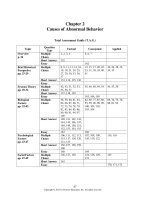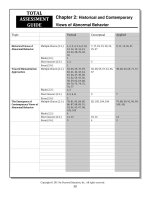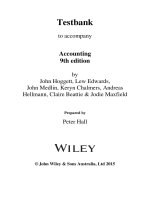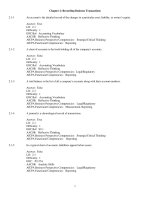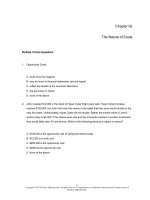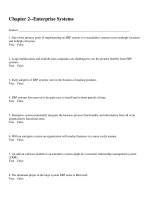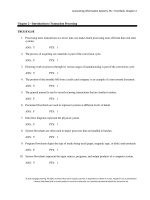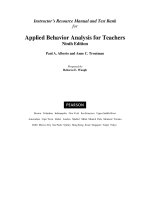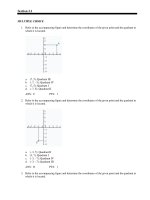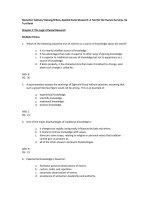Social psychology 9th edition kassin test bank
Bạn đang xem bản rút gọn của tài liệu. Xem và tải ngay bản đầy đủ của tài liệu tại đây (242.4 KB, 29 trang )
CHAPTER 2: DOING SOCIAL PSYCHOLOGY RESEARCH
MULTIPLE CHOICE
1. One major difference between research in social psychology versus research in other fields such as
chemistry is that
a. social psychology is less of a science than many other fields.
b. many people have commonsense intuitions about the questions that social psychologists
study empirically.
c. social psychologists are less likely to rely on empirical observation to draw conclusions.
d. in social psychology, researchers are less concerned with theories and more concerned
with data.
ANS: B
KEY: Conceptual
REF: Introductory Section
OBJ: 1
2. “Moms prefer Brand X of peanut butter,” a commercial claims. Sarah wonders what other brands were
used as the comparison group. Which benefit of learning about research methods is Sarah displaying?
a. Critical evaluation of information
b. Better memory for the results of studies
c. Better understanding of studies
d. Enhanced self-esteem
ANS: A
OBJ: 1
REF: Why Should You Learn About Research Methods?
KEY: Applied
NOT: New
3. Social psychologists use the scientific method when they study human behavior in order to
a. allow other social psychologists to attempt to replicate the findings.
b. ensure that the right people get credit for the research.
c. provide a solid theoretical foundation for social psychological research.
d. encourage social psychologists to conduct more basic, rather than applied, research.
ANS: A
KEY: Conceptual
REF: Introductory Section
OBJ: 1
4. Adarah is learning about research methods in her social psychology course. She will experience all of
the following benefits except
a. she will become a more critical consumer of information in general.
b. she will develop a better appreciation for the advantages of anecdotal stories.
c. the findings she learns about in class will be easier to understand and remember.
d. it will improve her reasoning about everyday events.
ANS: B
OBJ: 1
REF: Why Should You Learn About Research Methods?
KEY: Applied
NOT: New
5. All social psychological research must begin with a(n)
a. question.
b. independent variable.
c. subject variable.
d. control group.
ANS: A
OBJ: 1
REF: Developing Ideas: Beginning the Research Process
KEY: Factual
6. Which of the following concerning research questions in social psychology is false?
a. Research questions can be inspired by real-world events.
b. Social psychologists sometimes develop research questions based on their own personal
experiences and observations.
c. Social psychologists can only develop testable research questions by reading about prior
research in the field.
d. Music, poetry, and literature can all inspire research questions.
ANS: C
OBJ: 1
REF: Developing Ideas: Beginning the Research Process
KEY: Conceptual
7. Social psychologists use electronic databases, such as PsycInfo to
a. find published research on a particular topic.
b. determine the scientific and moral value of their research question.
c. help them select a random sample of participants from the population of interest.
d. increase the external validity of their research.
ANS: A
OBJ: 1
REF: Developing Ideas: Beginning the Research Process
KEY: Factual
8. One of the problems with searches for social psychological studies on the Internet generally, without
the aid of a database like PsycInfo, is that the results of such a search can vary wildly in
a. accuracy.
b. relevance.
c. quality.
d. All of these
ANS: D
OBJ: 1
REF: Developing Ideas: Beginning the Research Process
KEY: Factual
NOT: New
9. A hypothesis provides a means of ________ a theory.
a. testing
b. proving
c. generalizing
d. creating
ANS: A
OBJ: 2
REF: Developing Ideas: Beginning the Research Process
KEY: Conceptual
10. Which of the following is not a testable hypothesis?
a. Women tend to have more opposite-sex friends than men.
b. Stereotypes are more likely to impact judgments when people are tired.
c. People smile more when they are lying than when they are telling the truth.
d. Refusing to help someone in need is morally wrong.
ANS: D
OBJ: 2
REF: Developing Ideas: Beginning the Research Process
KEY: Conceptual
11. Hypotheses must be all of the following except
a. explicit.
b. testable.
c. predictive.
d. comprehensive.
ANS: D
OBJ: 2
REF: Developing Ideas: Beginning the Research Process
KEY: Factual
12. An explicit, testable prediction about the conditions under which an event will occur is a(n)
a. theory.
b. independent variable.
c. hypothesis.
d. correlation coefficient.
ANS: C
OBJ: 2
REF: Developing Ideas: Beginning the Research Process
KEY: Factual
NOT: New
13. An organized set of principles used to explain observed phenomena is called a(n)
a. theory.
b. hypothesis.
c. educated guess.
d. personal bias.
ANS: A
OBJ: 2
REF: Developing Ideas : Beginning the Research Process
KEY: Factual
NOT: New
14. The problem with Freudian theory was that
a. it failed to generate new hypotheses.
b. it was not sufficiently testable.
c. it did not pique the interest of other researchers of the time.
d. it did not enhance our understanding of psychological processes.
ANS: B
OBJ: 2
REF: Developing Ideas: Beginning the Research Process
KEY: Conceptual NOT: New
15. All else being equal, social psychologists prefer a(n) ________ theory to a(n) _______ theory.
a. complex; simple
b. simple; complex
c. intuitive; counterintuitive
d. popular; unpopular
ANS: B
OBJ: 2
REF: Developing Ideas: Beginning the Research Process
KEY: Factual
16. Britney believes that exposure to violent television increases aggressive behavior by making people’s
own aggressive thoughts more accessible. Christina believes that violent television increases
aggressive behavior by impairing people’s cognitive abilities, which in turn makes them worry less
about the consequences of their behavior as well as more likely to have aggressive thoughts. If we
knew that violent television indeed increases aggressive behavior but knew nothing else on this topic,
which of the two theories should we prefer?
a. Britney’s because it is more testable than Christina’s
b. Britney’s because it is simpler than Christina’s
c. Christina’s because it is more empirical than Britney’s
d. Christina’s because it is more testable than Britney’s
ANS: B
OBJ: 2
REF: Developing Ideas: Beginning the Research Process
KEY: Applied
17. All of the following are goals of basic research except
a. solving practical or real-world problems.
b. testing psychological theories.
c. building a foundation of knowledge for the field.
d. discovering general principles of behavior.
ANS: A
OBJ: 1
REF: Developing Ideas: Beginning the Research Process
KEY: Conceptual
18. Melissa’s research examines the cognitive processes involved in persuasion and how those processes
can be used to persuade women to have yearly mammograms. This work represents an integration of
a. hypothetical and theoretical research.
b. specific and general research.
c. basic and applied research.
d. independent and dependent research.
ANS: C
OBJ: 1
REF: Developing Ideas: Beginning the Research Process
KEY: Applied
19. Which of the following best describes the primary goal of basic research?
a. To examine human behavior in real-world settings
b. To test specific hypotheses derived from a specific theory
c. To integrate the different research methodologies within one subfield of social psychology
d. To solve practical problems
ANS: B
OBJ: 1
REF: Developing Ideas: Beginning the Research Process
KEY: Factual
20. In encouraging social psychologists to generate useful, practical theories, Kurt Lewin
a. set apart reliability issues from validity issues.
b. urged the synthesis of basic and applied research.
c. reduced the distinction between hypotheses and theories.
d. emphasized the importance of experimental methodologies.
ANS: B
OBJ: 1
REF: Developing Ideas: Beginning the Research Process
KEY: Conceptual
21. Which of the following is not true of applied research in social psychology?
a. It was pioneered by Kurt Lewin.
b. It is more experimental than basic research.
c. It contributes to solutions of social problems.
d. It is often conducted by researchers who also conduct basic research.
ANS: B
OBJ: 1
REF: Developing Ideas: Beginning the Research Process
KEY: Conceptual
22. Sapna is interested in the influence of nutrition on reaction time. She assigns participants to eat a salad
and fruit for dinner every day for a week or to eat fast food each day. She then brings participants into
the lab and asks them to push a button on a keyboard as fast as they can every time they hear a
particular sound. What are the operational definitions of the variables in Sapna’s study?
a. Nutrition; whether participants eat a salad or fast food
b. Nutrition; reaction time
c. Whether participants eat salad or fast food; reaction time
d. Whether participants eat salad or fast food; how quickly they push the button when they
hear the sound
ANS: D
OBJ: 2
REF: Refining Ideas: Defining and Measuring Social Psychological Variables
KEY: Applied
23. A researcher wanted to see if alcohol consumption raises or lowers a person’s self-esteem. In one
condition, he gives participants three glasses of punch spiked with alcohol and in the other he gives
participants three glasses of plain punch. After participants finish their punch, they complete the
Rosenberg (1965) self-esteem scale. In this study, self-esteem is the ________ and the score on the
Rosenberg questionnaire is the ________.
a. conceptual independent variable; operational independent variable
b. conceptual dependent variable; operational dependent variable
c. operational dependent variable; conceptual dependent variable
d. conceptual independent variable; operational dependent variable
ANS: B
OBJ: 2
REF: Refining Ideas: Defining and Measuring Social Psychological Variables
KEY: Applied
24. Construct validity is best defined as the extent to which
a. the independent variable caused the observed change in the dependent variable.
b. the operational definitions reflect the conceptual variables of interest.
c. the experimental procedures are involving and meaningful to the participants.
d. different constructs within the study are correlated with one another.
ANS: B
OBJ: 2
REF: Refining Ideas: Defining and Measuring Social Psychological Variables
KEY: Factual
25. Which of the following is false about construct validity?
a. It is relevant to both the dependent and independent variables in a study.
b. It can be identical for two researchers who have different operational definitions of the
same conceptual variable.
c. It ensures that the study is high in internal validity.
d. It facilitates the testing of both hypotheses and theories.
ANS: C
OBJ: 2
REF: Refining Ideas: Defining and Measuring Social Psychological Variables
KEY: Conceptual
26. In a study concerning the cues that signal deception, Winston uses the number of times a person shifts
in his or her seat as a measure of lying. Virginia points out that people may shift their position because
they are nervous about being perceived as a liar, even though they are actually telling the truth.
Virginia is questioning the _____ of Winston’s measure of lying.
a. construct validity
b. interrater reliability
c. mundane realism
d. internal validity
ANS: A
OBJ: 2
REF: Refining Ideas: Defining and Measuring Social Psychological Variables
KEY: Applied
27. Which of the following statements concerning self-report measures is false?
a. They allow researchers access to individuals’ private thoughts and feelings.
b. They are not influenced by the phrasing of a question or the response options provided.
c. They are sometimes inaccurate because people intentionally present themselves in a
socially desirable way.
d. One problem they have is that individuals may not explicitly remember the thoughts or
behaviors they are asked about.
ANS: B
OBJ: 3
REF: Refining Ideas: Defining and Measuring Social Psychological Variables
KEY: Factual
28. Your book describes a study in which participants were provided with information about either the
success rate or failure rate of condoms. The findings of this study indicate that
a. college students tend to be naively ignorant of the risks associated with some of their
behaviors.
b. the simple wording and/or positioning of a question can have a drastic effect on self-report
responses.
c. participants often lie when they are asked about sensitive personal issues.
d. All of these
ANS: B
OBJ: 3
REF: Refining Ideas: Defining and Measuring Social Psychological Variables
KEY: Conceptual
29. Which of the following has been shown to increase the accuracy of self-reports?
a. Experimental research
b. Construct validity
c. Bogus pipeline
d. Random sampling
ANS: C
OBJ: 3
REF: Refining Ideas: Defining and Measuring Social Psychological Variables
KEY: Factual
30. Researchers have developed interval-contingent, signal-contingent, and event-contingent report
methods to
a. reduce memory distortions in self-report measures.
b. amplify memory distortions in self-report measures.
c. increase the role of values in the research process.
d. observe participants’ behavior unobtrusively.
ANS: A
OBJ: 3
REF: Refining Ideas: Defining and Measuring Social Psychological Variables
KEY: Conceptual NOT: New
31. In comparison to self-report measures, observational measures are not affected by
a. experimenter expectancy effects.
b. participants’ social desirability concerns.
c. sampling biases.
d. participants’ memory biases.
ANS: D
OBJ: 3
REF: Refining Ideas: Defining and Measuring Social Psychological Variables
KEY: Factual
32. Self-report measures and observational measures are similar in that both
a. can be influenced by social desirability concerns.
b. require high interrater reliability to be considered accurate.
c. are subject to biases and distortions in memory.
d. provide direct access to people’s thoughts and feelings.
ANS: A
OBJ: 3
REF: Refining Ideas: Defining and Measuring Social Psychological Variables
KEY: Conceptual
33. To assess the extent to which students are reading their textbooks, a professor notes how creased the
spine of each book is. This professor is relying on
a. a descriptive study.
b. signal-contingent self-reports.
c. event-contingent self-reports.
d. observational measures.
ANS: D
OBJ: 3
REF: Refining Ideas: Defining and Measuring Social Psychological Variables
KEY: Applied
34. Johanna is participating in a study on social contacts and subjective well-being. Each evening around 6
p.m., Johanna is supposed to record in a journal the number of social interactions she had that day that
were longer in duration than 5 minutes. The researcher is using _____ self-report in this study.
a. interval-contingent
b. event-contingent
c. signal-contingent
d. bogus pipeline
ANS: A
OBJ: 3
REF: Refining Ideas: Defining and Measuring Social Psychological Variables
KEY: Applied
NOT: New
35. Johanna is participating in a study on social contacts and subjective well-being. At random times
during the day, she receives a text message to which she responds with information about who she was
with and how happy she is feeling. The researcher is using _____ self-report in this study.
a. interval-contingent
b. event-contingent
c. signal-contingent
d. bogus pipeline
ANS: C
OBJ: 3
REF: Refining Ideas: Defining and Measuring Social Psychological Variables
KEY: Applied
NOT: New
36. Rhianna is participating in a study on social contacts and subjective well-being. After each social
interaction that is longer than 5 minutes in duration, Rhianna logs into a site and responds to a series of
questions about how she is feeling. The researcher is using _____ self-report in this study.
a. interval-based
b. event-based
c. signal-based
d. bogus pipeline
ANS: B
OBJ: 3
REF: Refining Ideas: Defining and Measuring Social Psychological Variables
KEY: Applied
NOT: New
37. Which of the following examples best reflects the use of interrater reliability?
a. In a study examining the creativity of children’s paintings, several judges are asked to rate
the creativity of each painting. The degree to which the judges agree in their ratings is
assessed.
b. In a study examining the favorite foods of college students, a large sample of students rate
several foods according to their preferences. The degree to which students’ responses are
correlated is assessed.
c. In a study examining toy preferences of toddlers, the children are left alone to play with
several toys for an hour. During the first half-hour, one researcher observes their play.
During the second half-hour, a second researcher observes their play. The researchers’
observations are then compared.
d. In a study examining well-being in the elderly, respondents living in different nursing
homes are asked to rate the quality of their nursing home. Researchers then obtain a copy
of participants’ medical records. The relationship between the quality ratings and actual
health is assessed.
ANS: A
OBJ: 3
REF: Refining Ideas: Defining and Measuring Social Psychological Variables
KEY: Applied
38. Which of the following is not mentioned in your book as a new technology used by social
psychologists in obtaining observational data?
a. Polygraphs (lie detector machines)
b. Eye tracking
c. fMRI
d. Computer-based reaction time measurement
ANS: A
OBJ: 4
REF: Refining Ideas: Defining and Measuring Social Psychological Variables
KEY: Factual
39. The different research methods used by social psychologists tend to emphasize all of the following
except
a. an objective approach.
b. a variable approach.
c. a systematic approach.
d. a quantifiable approach.
ANS: B
KEY: Factual
REF: Testing Ideas: Research Designs
OBJ: 4
40. Social psychologists tend to prefer which of the following research methods above all others?
a. Meta-analysis
b. Correlational research
c. Experimentation
d. Descriptive research
ANS: C
KEY: Factual
REF: Testing Ideas: Research Designs
OBJ: 4
41. Social psychologists use descriptive research in order to describe
a. general patterns and trends in the variables of interest.
b. cause-and-effect relationships between independent and dependent variables.
c. associations between two or more variables of interest.
d. the strength of an observed effect.
ANS: A
KEY: Conceptual
REF: Testing Ideas: Research Designs
OBJ: 4
42. A study that examines existing records or databases is referred to as a
a. case study.
b. archival study.
c. anecdotal study.
d. survey.
ANS: B
KEY: Factual
REF: Testing Ideas: Research Designs
OBJ: 4
43. For which of the following questions would a researcher be most likely to use an observational study?
a. Is memory for television commercials influenced by the tune of the music included in the
commercial?
b. Does taking a social psychology course cause one to be happier?
c. Does smoking marijuana lead to increased aggression?
d. Do banks tend to offer minorities lower interest rates on home mortgages than nonminorities?
ANS: D
KEY: Conceptual
REF: Testing Ideas: Research Designs
NOT: New
OBJ: 4
44. To examine potential gender differences in the qualities individuals seek in their romantic partners,
HaeJin compares the personal ads placed by men and women. HaeJin is conducting a(n)
a. survey study.
b. observational study.
c. archival study.
d. experiment.
ANS: C
KEY: Applied
REF: Testing Ideas: Research Designs
OBJ: 4
45. Latrell, the editor of a popular sports magazine, would like to know more about the demographics of
the magazine’s readers. He designs a questionnaire to assess this information and sends it to a random
sample of the magazine’s readers. Latrell is conducting a(n)
a. survey.
b. observational study.
c. archival study.
d. experiment.
ANS: A
KEY: Applied
REF: Testing Ideas: Research Designs
OBJ: 4
46. The most important aspect of sampling in a survey study is
a. its inclusion of equal numbers of individuals from different groups in the population.
b. the number of people in the sample.
c. the ratio of the sample size to the population size.
d. the extent to which the sample in this study matches the population proportionally in terms
of demographic variables.
ANS: D
KEY: Factual
REF: Testing Ideas: Research Designs
OBJ: 4
47. A television producer is interested in whether women like soap operas more than sitcoms. The
producer uses a random number table to select a sample of 100 households, and then makes phone
calls to these households every afternoon for three weeks. Of those who were home when the producer
called, 75% reported they liked soap operas more than sitcoms. Which of the following might raise
questions about the results?
a. The use of archival data
b. The representativeness of the sample
c. The construct validity of the measure
d. The operational definition advanced by the magazine
ANS: B
KEY: Applied
REF: Testing Ideas: Research Designs
OBJ: 4
48. Which of the following does not make use of random sampling?
a. Public opinion polling
b. Election Day exit polling
c. Market research telemarketing surveys
d. A population census
ANS: D
KEY: Applied
REF: Testing Ideas: Research Designs
OBJ: 4
49. In principle, the purpose of random sampling is to make sure that research participants
a. have the right to withdraw from a study without incurring any penalty.
b. are fully informed as to the procedures and hypotheses of the study.
c. do not differ from one another in systematic ways.
d. constitute a representative sample from the population of interest.
ANS: D
KEY: Conceptual
REF: Testing Ideas: Research Designs
OBJ: 4
50. What is one general difference between descriptive and correlational research methods?
a. Descriptive research does not look at relationships between variables.
b. Descriptive research is more useful when one wants to infer causation.
c. Correlational research cannot make use of archival data.
d. Correlational research imbues the researcher with more control over the research
participants.
ANS: A
KEY: Conceptual
REF: Testing Ideas: Research Designs
OBJ: 5
51. Luke would like to know if there is a relationship between the number of psychology courses people
take and their level of empathy. He surveys a randomly selected group of college students. Each
student indicates the number of psychology courses he or she has taken and then completes an
empathy scale. Luke’s research is best described as a(n)
a. correlational study.
b. experiment.
c. prospective study.
d. archival study.
ANS: A
KEY: Applied
REF: Testing Ideas: Research Designs
OBJ: 5
52. The primary goal of using correlational research is to
a. determine the causal relationship between an independent and dependent variable.
b. describe the population’s average score on a particular measure.
c. manipulate one variable but hold the other constant.
d. determine the nature and strength of the association between two measured variables.
ANS: D
KEY: Conceptual
REF: Testing Ideas: Research Designs
OBJ: 5
53. Which of the following statements concerning correlational research is true?
a. In correlational research, variables are measured but not manipulated.
b. In correlational research, one variable is manipulated and one is measured.
c. Correlational research can be conducted using observational, but not archival, measures.
d. Correlational research can be conducted using archival, but not observational, measures.
ANS: A
KEY: Conceptual
REF: Testing Ideas: Research Designs
OBJ: 5
54. The sign on a correlation indicates the _____ of the relationship between the two variables it measures.
a. nature, or quality,
b. strength
c. power
d. direction
ANS: A
KEY: Conceptual
REF: Testing Ideas: Research Designs
NOT: New
OBJ: 5
55. Which of the following correlation coefficients reflects the strongest meaningful relationship?
a. –0.67
b. 0
c. +0.86
d. +1.25
ANS: C
KEY: Factual
REF: Testing Ideas: Research Designs
OBJ: 5
56. When decreases in one variable are accompanied by decreases in another variable, the variables are
described as
a. negatively correlated.
b. positively correlated.
c. causally related.
d. prospectively related.
ANS: B
KEY: Conceptual
REF: Testing Ideas: Research Designs
OBJ: 5
57. Vito finds a correlation of –0.35 between procrastination behaviors and academic achievement. Which
of the following is an appropriate conclusion for Vito to draw?
a. Procrastination leads students to perform more poorly.
b. Poor academic performance causes more procrastination.
c. Elimination of procrastination behaviors will lead students to perform better.
d. None of these
ANS: D
KEY: Applied
REF: Testing Ideas: Research Designs
OBJ: 5
58. Carmella finds a correlation of +0.47 between self-esteem and academic achievement. Which of the
following is the most appropriate interpretation of this correlation?
a. High self-esteem motivates students to achieve more academically.
b. Doing well academically increases students’ self-esteem.
c. The higher students’ self-esteem, the greater their academic achievement.
d. As self-esteem increases, academic achievement decreases.
ANS: C
KEY: Applied
REF: Testing Ideas: Research Designs
OBJ: 5
59. Which of the following is an example of a negative correlation?
a. The more pets you own, the greater your physical health tends to be.
b. The more money people make, the bigger their house tends to be.
c. The more alcohol you consume, the lower your GPA tends to be.
d. The more points, the higher the score.
ANS: C
KEY: Conceptual
REF: Testing Ideas: Research Designs
OBJ: 5
60. Suppose the correlation between the number of times couples go to the movies and the number of
times they go out to dinner is +0.79. Among the following conclusions, which one is not consistent
with this computation?
a. The more often that couples go to the movies, the more often they go out to dinner.
b. The less often that couples go to the movies, the less often they go out to dinner.
c. There is a strong positive correlation between the number of times couples go to the
movies and the number of times they go out to dinner.
d. Because the correlation coefficient is less than 1.0, the association between these two
variables is very weak and probably unreliable.
ANS: D
KEY: Applied
REF: Testing Ideas: Research Designs
OBJ: 5
61. Dr. Vandelay found the correlation between shoe size and sexual deviancy to be +0.83. Which of the
following can you conclude from this correlation?
a. As shoe size increases, sexual deviancy increases.
b. As shoe size increases, sexual deviancy decreases.
c. There is virtually no relationship between shoe size and sexual deviancy.
d. Engaging in sexually deviant acts causes your feet to grow.
ANS: A
KEY: Applied
REF: Testing Ideas: Research Designs
OBJ: 5
62. Camryn uses a survey to measure the association between students’ grade point average and weekly
consumption of alcohol. She finds that higher GPAs tend to predict lower levels of alcohol
consumption (and vice versa). This study is best described as a(n)
a. experiment.
b. observational study.
c. concurrent study.
d. correlational study.
ANS: D
KEY: Applied
REF: Testing Ideas: Research Designs
OBJ: 5
63. One of the many advantages of correlational research is that
a. it allows researchers to study variables that cannot be manipulated in the lab.
b. it allows the researcher to test for and determine the nature of causal relationships.
c. it exhibits high internal validity.
d. it tends to be statistically significant.
ANS: A
KEY: Conceptual
REF: Testing Ideas: Research Designs
OBJ: 5
64. Which of the following statements concerning correlational research is false?
a. Correlational research aids researchers in the development of new hypotheses.
b. Correlational research permits researchers to determine whether one variable can predict
another.
c. Correlational research is often useful for studying phenomena for which experimentation
is impractical or unethical.
d. Correlational research allows researchers to measure relationships between independent
and dependent variables.
ANS: D
KEY: Conceptual
REF: Testing Ideas: Research Designs
OBJ: 5
65. Which of the following is true of correlational research?
a. It is a powerful way to establish causal relationships between variables.
b. It allows an experimenter to control extraneous variables.
c. It permits researchers to determine whether one variable is predictive of another.
d. It is limited to the study of variables that can be measured in the laboratory.
ANS: C
KEY: Conceptual
REF: Testing Ideas: Research Designs
OBJ: 5
66. Relative to experimental studies, the primary disadvantage of correlation studies is that
a. they are more labor-intensive.
b. cause and effect cannot be determined with them.
c. the results are more difficult to understand.
d. the choice of variables that can be studied is limited.
ANS: B
KEY: Factual
REF: Testing Ideas: Research Designs
OBJ: 5
67. Causation cannot be inferred from correlational studies because
a. they are so low in external validity.
b. they do not involve the manipulation of variables.
c. they are always conducted outside of the research lab.
d. researchers have too much control over the variables in correlational research.
ANS: B
KEY: Conceptual
REF: Testing Ideas: Research Designs
OBJ: 5
68. Experiments require all of the following except
a. equal treatment of participants in different groups except for the manipulation of the
independent variable.
b. control over experimental procedures.
c. manipulation of an independent variable.
d. a laboratory environment.
ANS: D
KEY: Factual
REF: Testing Ideas: Research Designs
OBJ: 6
69. In a well-designed experiment, all participants must
a. be treated in exactly the same manner except for the specific differences the experimenter
wants to create.
b. not realize that they are involved in an experiment.
c. be influenced by experimenter expectancy effects.
d. be allowed to choose their own experimental conditions without interference or bias from
the experimenter.
ANS: A
KEY: Factual
REF: Testing Ideas: Research Designs
OBJ: 6
70. Buster runs an experiment in which she finds that participants placed in a good mood by a happy film
clip are more likely to offer help to a fellow participant than participants who see a sad film clip. Gob
suggests that perhaps this difference simply results from the fact that the participants in the happy film
clip condition were more helpful people to begin with. What methodological aspect of a successful
experiment can Buster point to in order to refute this criticism?
a. External validity
b. Random selection
c. Random assignment
d. Manipulation
ANS: C
KEY: Applied
REF: Testing Ideas: Research Designs
OBJ: 6
71. Among the following, which is most relevant to ensuring that any differences one obtains after the
experimental manipulation of a study have been produced only by that manipulation?
a. Statistical interactions
b. External validity
c. Construct validity
d. Experimenter control
ANS: D
KEY: Conceptual
REF: Testing Ideas: Research Designs
OBJ: 6
72. Random assignment is a defining feature of an experiment. It means that
a. participants are able to select the particular experimental manipulations they wish to
experience.
b. participants were randomly selected from the population of interest.
c. whether participants are in one condition or another is determined at random.
d. participants are assigned to the experimental conditions on the basis of their pre-existing
differences.
ANS: C
KEY: Factual
REF: Testing Ideas: Research Designs
OBJ: 6
73. A researcher was interested in the effects of mood on aggression. She decided to see how receiving an
insult or a compliment affects aggression, and she measured aggression by having participants
administer small shocks to another participant. The researcher found that participants in the insult
condition were more aggressive than those in the compliment condition. One of her colleagues reads
about this research and voices concern that people in the insult condition may have been more
naturally aggressive than people in the compliment condition, causing the differences observed by the
researcher. This concern about pre-existing differences between participants in the two conditions
would only be valid if
a. participants were not a representative sample of the population.
b. participants were not randomly assigned to the condition.
c. participants were not randomly selected from the population.
d. All of these
ANS: B
KEY: Conceptual
REF: Testing Ideas: Research Designs
OBJ: 6
74. Random assignment is essential to establishing causality because it
a. permits researchers to verify that they have a diverse and representative sample of
participants.
b. reduces the possibility that individual characteristics of the participants produced the
observed results.
c. increases the external validity of the experiment.
d. allows researchers to determine whether or not their operational definitions reflect the
variables of interest.
ANS: B
KEY: Conceptual
REF: Testing Ideas: Research Designs
OBJ: 6
75. The procedure used to ensure that research participants have an equal chance of being placed in either
the experimental or control group in an experiment is called
a. random assignment.
b. random sampling.
c. debriefing.
d. experimental realism.
ANS: A
KEY: Factual
REF: Testing Ideas: Research Designs
OBJ: 6
76. In comparison to field experiments, laboratory experiments
a. permit researchers greater control.
b. allow more naturalistic observation of behavior.
c. are less susceptible to experimenter expectancy effects.
d. have fewer problems caused by the limitations of self-report data.
ANS: A
KEY: Conceptual
REF: Testing Ideas: Research Designs
OBJ: 6
77. In an experiment, the independent variable is _______ while the dependent variable is _______.
a. held constant; varied
b. correlational; descriptive
c. manipulated; measured
d. general; specific
ANS: C
KEY: Conceptual
REF: Testing Ideas: Research Designs
OBJ: 6
78. Subject variables are characterized by all of the following except
a. they are neither dependent nor truly independent variables.
b. they cannot be manipulated or randomly assigned.
c. they may include gender and ethnicity of participants.
d. they are essential for field experiments.
ANS: D
KEY: Conceptual
REF: Testing Ideas: Research Designs
OBJ: 6
79. To examine the impact of group size on conformity behavior, Stanley has groups of two, five, or ten
people stand on a city street and stare up at a window. Stanley then records the number of passersby
who stop and stare at the window. This study is an example of a(n)
a. meta-analysis.
b. archival study.
c. experiment with one independent variable.
d. experiment with two independent variables.
ANS: C
KEY: Applied
REF: Testing Ideas: Research Designs
OBJ: 6
80. Professor Collison studies the impact of violent video games on aggression. Aggression is the _____ in
this research.
a. independent variable
b. dependent variable
c. interaction term
d. subject variable
ANS: B
KEY: Applied
REF: Testing Ideas: Research Designs
NOT: New
OBJ: 6
81. Vera thinks that having pets increases psychological functioning and well-being. To test this, one
group of randomly selected nursing home residents is each given a pet while a second group is not.
Over two months, the overall level of psychological functioning is evaluated on a daily basis. What is
the independent variable in this study?
a. Having pets increases psychological functioning
b. Whether or not the residents received a pet
c. The level of psychological functioning demonstrated by the residents
d. This is a correlational study, so there is no independent variable.
ANS: B
KEY: Applied
REF: Testing Ideas: Research Designs
OBJ: 6
82. Barb examines the impact that sitting in front of a mirror has on the academic performance of female
adolescents. In her study, the number of math questions answered correctly appears to be the
a. conceptual independent variable.
b. conceptual dependent variable.
c. operational definition of the independent variable.
d. operational definition of the dependent variable.
ANS: D
KEY: Applied
REF: Testing Ideas: Research Designs
OBJ: 6
83. Castilla wonders whether environmental factors influence how long juries take to select a foreperson.
Mock jurors are brought into a room with either a rectangular table or a round table. The jurors are
asked to select a foreperson before starting deliberation. Castilla records how long it takes each jury to
select a foreperson. The shape of the table is the
a. independent variable.
b. dependent variable.
c. subject variable.
d. control variable.
ANS: A
KEY: Applied
REF: Testing Ideas: Research Designs
OBJ: 6
84. Robinson manipulates two variables in his experimental investigation of test-taking performance: the
number of participants seated in the room and the room temperature. He finds that regardless of the
temperature in the room, participants do better on the test when the room is less crowded. Which of the
following statements about this study is true?
a. There are two independent variables in this study.
b. There is one independent variable in this study.
c. There are two dependent variables in this study.
d. None of these
ANS: A
KEY: Applied
REF: Testing Ideas: Research Designs
OBJ: 6
85. Natasha finds that men speak more often in the classroom than do women, and that this is true both
when they are assigned to sit in the front of the room and the back of the room. Natasha’s study has
found a statistically significant effect for
a. the independent variable she manipulated.
b. a subject variable.
c. the conceptual but not the operational variable.
d. the experimental but not the correlational variable.
ANS: B
KEY: Applied
REF: Testing Ideas: Research Designs
OBJ: 7
86. What does it mean to say that an experiment has two independent variables?
a. The researcher has created a study with two different conditions.
b. The researcher has come up with two different measures to take in order to test the
hypothesis.
c. The researcher is manipulating two different variables in the course of the study.
d. The effects of one variable in the study have nothing to do with the effects of the other
variable.
ANS: C
KEY: Conceptual
REF: Testing Ideas: Research Designs
OBJ: 6
87. To examine the impact of mood on prosocial behavior, Leila had participants watch a video intended
to put them in either a positive or neutral mood before asking them to make a donation to a fictitious
charity. Which of the following is the operational dependent variable in this study?
a. Mood
b. Happy or sad video
c. Prosocial behavior
d. Donation to charity
ANS: D
KEY: Applied
REF: Testing Ideas: Research Designs
OBJ: 6
88. Rabiyah administered an intelligence test to sophomore and seniors at Faber College and at Hillman
College and compared performance across these four groups. Which of the following is/are the subject
variable(s) in this study?
a. Being a sophomore versus a senior
b. Attending Faber versus Hillman College
c. Scoring high versus low on intelligence
d. Both being a sophomore versus a senior and attending Faber versus Hillman College
ANS: D
KEY: Applied
REF: Testing Ideas: Research Designs
NOT: New
OBJ: 6
89. Achieving _________ is typically more of a challenge in a field study than in a laboratory study.
a. high external validity
b. high internal validity
c. high mundane realism
d. cross-cultural reliability
ANS: B
KEY: Conceptual
REF: Testing Ideas: Research Designs
OBJ: 7
90. Tobias Greitemeyer and colleagues (2012) conducted a set of studies in which he examined the effect
of type of video game played on aggression. He found that
a. the type of video game played had no effect on participants’ choice of how loud to blast a
noise at someone.
b. participants used lower volume of a blast if they had played a video game that involved
helping.
c. participants who played a neutral video game were more likely to choose the quietest
noise blast.
d. participants who played a video game that was violent were more likely to choose the
quietest noise blast.
ANS: B
KEY: Factual
REF: Testing Ideas: Research Designs
NOT: New
OBJ: 7
91. The independent variable in Greitemeyer and colleagues’ (2012) experiment on video game content
and aggression was
a. exposure to a helpful, neutral, or violent video game.
b. the volume of the noise blast given to a person.
c. whether or not a noise blast was given to a person.
d. score on an aggression personality measure.
ANS: A
KEY: Conceptual
REF: Testing Ideas: Research Designs
NOT: New
OBJ: 6
92. The study by Claire Ashton-James et al. (2009) (in which mood and cultural differences were
explored) examined whether
a. mood could cause individuals to act in novel ways.
b. Western participants were more likely to act in ways that are inconsistent with cultural
norms.
c. East Asian participants were less likely to choose the uncommon color pen.
d. positive mood would make all participants more likely to choose the common color pen.
ANS: A
KEY: Conceptual
REF: Testing Ideas: Research Designs
OBJ: 7
93. The color pen that participants chose in the Ashton-James et al. (2009) study is best described as a(n)
a. dependent variable.
b. subject variable.
c. manipulated variable.
d. independent variable.
ANS: A
KEY: Applied
REF: Testing Ideas: Research Designs
OBJ: 6
94. A subject variable in the Ashton-James et al. (2009) study was
a. the color pen that the participant selected.
b. the type of music that the participant listened to.
c. whether the participant was from a Western or East Asian background.
d. the mood of the participant at the end of the study.
ANS: C
KEY: Applied
REF: Testing Ideas: Research Designs
OBJ: 6
95. Ashton-James and colleagues (2009) had how many true independent variables in their study?
a. One--mood manipulation
b. Two--mood manipulation and cultural background
c. Three--mood manipulation, cultural background, and which pen to choose
d. None, as Ashton-James’ study was observational rather than experimental.
ANS: A
KEY: Conceptual
REF: Testing Ideas: Research Designs
NOT: New
OBJ: 6
96. When researchers find that the results of their studies could have occurred by chance only five or
fewer times in 100 possible outcomes, they conclude that the results
a. are statistically significant.
b. reflect an interaction between the dependent variables.
c. are theoretically meaningful.
d. are null because of their low level of reliability.
ANS: A
KEY: Conceptual
REF: Testing Ideas: Research Designs
OBJ: 7
97. Zachary observes a significant negative correlation between binge drinking and grades among college
students. Which of the following is true?
a. There is a 5 percent probability or less that this correlation occurred by chance.
b. Zachary cannot be sure what causes what, but he can be sure that either binge drinking
causes lower grades or vice versa.
c. Zachary will probably try to replicate his findings by conducting an experiment.
d. Zachary would not have been able to conduct the study if students received written
evaluations from instructors rather than grades.
ANS: A
KEY: Applied
REF: Testing Ideas: Research Designs
OBJ: 7
98. According to standard convention, a researcher must be ___ percent sure that the difference she
observed between experimental conditions was not simply the result of chance in order to conclude
that the difference is statistically significant.
a. 90
b. 95
c. 99
d. 99.9
ANS: B
KEY: Factual
REF: Testing Ideas: Research Designs
OBJ: 7
99. The emphasis on the importance of replication of results in social psychology has _____ in recent
years.
a. increased
b. remained constant
c. decreased
d. ebbed and flowed
ANS: A
KEY: Factual
REF: Testing Ideas: Research Designs
NOT: New
OBJ: 7
100. One reason that social psychologists attempt to replicate the results of their research is that doing so
a. reduces the probability that the results are due to chance.
b. increases the construct validity of the experiment.
c. allows them to examine multiple relationships among variables.
d. increases the likelihood that participants have been treated ethically.
ANS: A
KEY: Conceptual
REF: Testing Ideas: Research Designs
OBJ: 7
101. A factor other than the independent variable that varies between conditions of an experiment is called
a(n)
a. confound.
b. experimenter effect.
c. subject effect.
d. expectancy effect.
ANS: A
KEY: Factual
REF: Testing Ideas: Research Designs
NOT: New
OBJ: 7
102. A confound is a threat to _____ validity.
a. external
b. construct
c. internal
d. content
ANS: C
KEY: Conceptual
REF: Testing Ideas: Research Designs
NOT: New
OBJ: 7
103. Megumi is running an experiment on the impact of noise level on subsequent aggressive behavior. In
one condition, participants experience a loud, annoying noise while trying to complete a task, and then
are given a chance later to give another ostensible participant a noise blast, too. In the other condition,
the participants do not experience the noise while trying to complete their task; the loud room is also
lit more brightly than the quiet room. This difference in the level of light is an example of a(n)
a. confound.
b. control group.
c. threat to external validity.
d. subject variable.
ANS: A
KEY: Applied
REF: Testing Ideas: Research Designs
NOT: New
OBJ: 7
104. Participants who are subjected to all of the experimental procedures except the experimental
manipulation are called
a. raters.
b. confederates.
c. samples.
d. controls.
ANS: D
KEY: Factual
REF: Testing Ideas: Research Designs
OBJ: 7
105. The purpose of using control groups is to
a. address ethical concerns about experiments.
b. determine if there are any interactions among the independent variables.
c. ensure a high level of experimental realism.
d. provide a baseline against which to compare the effects of the independent variables.
ANS: D
KEY: Conceptual
REF: Testing Ideas: Research Designs
OBJ: 7
106. The best solution to the problem of experimenter expectancy effects is
a. the use of different experimenters in different conditions.
b. letting participants choose their own condition.
c. keeping experimenters uninformed about group assignment.
d. strict attention to random assignment.
ANS: C
KEY: Factual
REF: Testing Ideas: Research Designs
OBJ: 7
107. You are a new researcher in a social psychology lab. The study you are working on is examining the
effects of alcohol on aggressiveness. You are aware of the hypotheses of the study and eager to find
evidence that supports them, and you find yourself acting in a less polite manner with participants who
are assigned to the alcohol condition. This differential treatment of participants across conditions will
threaten
a. the statistical significance of the results.
b. the internal validity of the study.
c. the external validity of the study.
d. None of these
ANS: B
KEY: Applied
REF: Testing Ideas: Research Designs
OBJ: 7
108. Rosenthal and Fode (1968) asked students to teach a rat to learn a maze. Some students were told they
had been given a genetically engineered “intelligent” rat, whereas others were told that they had a
“dull” rat. Although there were no actual differences among the rats, the “intelligent” rats learned the
maze more quickly than the “dull” rats. Which of the following topics discussed in your book can best
explain the results of this experiment?
a. Experimenter expectancy effects
b. Mundane realism
c. Experimental realism.
d. High construct validity
ANS: A
KEY: Applied
REF: Testing Ideas: Research Designs
OBJ: 7
109. External validity refers to the degree to which
a. there can be reasonable certainty that the independent variables in an experiment caused
the observed effects on the dependent variables.
b. there can be reasonable confidence that the same results would be obtained for other
people and in other situations.
c. participants were assigned to the various conditions on the basis of representative criteria.
d. the experimental situation engages participants and leads them to behave naturally and
spontaneously.
ANS: B
KEY: Factual
REF: Testing Ideas: Research Designs
OBJ: 7
110. A social psychologist wants to study the impact of listening to classical music on people’s level of
comfort in social interactions. She runs a study using a convenience sample of college undergraduates.
The use of this particular sample is a threat to
a. mundane realism.
b. experimental realism.
c. internal validity.
d. external validity.
ANS: D
KEY: Applied
REF: Testing Ideas: Research Designs
OBJ: 7
111. Joel argues that the use of confederates provides for real interactions that emulate the types of
reactions that occur in real life. Dale argues that the use of confederates simply makes an experiment
more involving for the participant. Which of the following is true?
a. Joel and Dale both believe that confederates increase mundane realism.
b. Joel and Dale both believe that confederates increase experimental realism.
c. Joel believes that confederates increase mundane realism; Dale believes that confederates
increase experimental realism.
d. Joel believes that confederates increase experimental realism; Dale believes that
confederates increase mundane realism.
ANS: C
KEY: Applied
REF: Testing Ideas: Research Designs
OBJ: 8
112. The reliance of many social psychology studies on college student participants poses a threat to
a. internal validity.
b. external validity.
c. mundane realism.
d. experimental realism.
ANS: B
KEY: Conceptual
REF: Testing Ideas: Research Designs
OBJ: 7
113. Advocates of basic research argue that the more _____ the principle being studied, the _____ it matter
who participates in the study, in terms of sample representativeness.
a. basic; less
b. applied; less
c. basic; more
d. complex; more
ANS: A
KEY: Factual
REF: Testing Ideas: Research Designs
NOT: New
OBJ: 7
114. A social dilemma experiment often involves an economic decision-making task in which participants
must decide to cooperate or compete with their partner based on various payoffs. Although the format
of the experiment does not resemble the real-world decisions participants may make, it is very
involving, and participants often become highly competitive. Based on this description, a social
dilemma experiment has
a. high mundane realism.
b. low mundane realism.
c. high experimental realism.
d. high experimental realism and low mundane realism.
ANS: D
KEY: Applied
REF: Testing Ideas: Research Designs
NOT: New
OBJ: 7
115. An accomplice of the experimenter who, in dealing with the real participants in an experiment, acts as
if he or she is also a participant is called a(n)
a. confederate.
b. union.
c. helper.
d. actor.
ANS: A
KEY: Factual
REF: Testing Ideas: Research Designs
NOT: New
OBJ: 8
116. Research using meta-analysis procedures
a. computes correlations among more than two variables.
b. approaches a research question using both correlational and experimental studies.
c. statistically assesses the consistency of several tests of the same hypothesis.
d. is used when self-report data regarding a particular topic are not available.
ANS: C
KEY: Factual
REF: Testing Ideas: Research Designs
OBJ: 7
117. Including culture as a subject variable in a study helps improve the _____ validity of the study.
a. internal
b. external
c. construct
d. content
ANS: B
KEY: Conceptual
REF: Testing Ideas: Research Designs
NOT: New
OBJ: 7
118. If a finding from one culture fails to generalize to a second culture, this should be viewed as a(n)
a. failure to replicate.
b. opportunity to study a potentially interesting cultural difference.
c. an indication of the second researcher to not adequately train confederates.
d. wasted effort, and shuts down future efforts to examine culture as a subject variable.
ANS: B
KEY: Conceptual
REF: Testing Ideas: Research Designs
NOT: New
OBJ: 7
